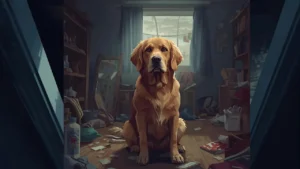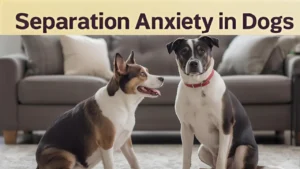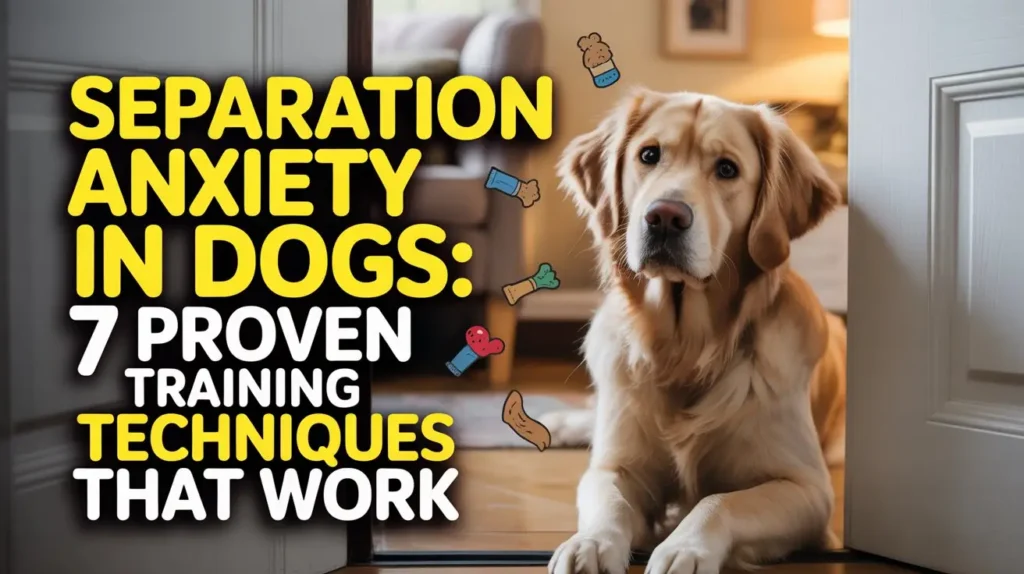All dog owners who seek to help their anxious canine need Separation Anxiety in Dogs training. Such behavior makes caring for your dog extremely difficult because their panic continues right after your departure. But don’t worry. It is possible to cure separation anxiety in dogs through proper methods as well as through the special application of commitment and professional help.
The Question What Separation Anxiety in Dogs is?

Separation Anxiety in Dogs, the condition goes beyond normal vocalization that dogs exhibit when their owner departs. It’s a serious condition. The symptoms of this disorder cause affected dogs to exhibit several concerning behaviors.
- Bark excessively
- Destroy furniture
- Scratch at doors
- Soil the house
- Try to escape
Separation Anxiety in Dogs, the unwillingness of your dog to behave properly signals that separation anxiety affects their mental state. Instead, they’re experiencing panic. The vital training method here is dog separation training.
Why Separation Anxiety in Dogs Develop?
Separation Anxiety in Dogs, The various elements lead to separation anxiety development in dogs. Common triggers include:
- A sudden change in schedule
- Moving to a new home
- Loss of a family member
- Adoption from a shelter
The identification of the underlying causes leads to successful training of anxiety in dogs. Your understanding of “why” leads to solutions about “how” to resolve them.
Step-By-Step training of Separation Anxiety in Dogs

Separation Anxiety in Dogs, various techniques exist to achieve your dog’s development of calmness and confidence during periods of alone time. The first requirement for making progress is maintaining persistent dedication throughout all stages of development.
1. Start With Short Departures
Separation Anxiety in Dogs, the first step involves having your dog experience solitary periods beginning with short time intervals. Walk to your shoes or take your keys without disturbing dog separation. Multi-step training progresses from five to ten minutes of absence over time. Gradually increase the duration. Anxious dog training critical needs this particular step.
The slow pace you perceive actually creates an effective basis for eventual achievements.
2. Use Crate Training Wisely
The use of crate training for Separation Anxiety in Dogs remain in debate yet proper implementation brings beneficial comfort to dogs. A crate functions best as a refuge instead of a disciplinary device.
- Use positive reinforcement
- Add toys and soft bedding
- The crate should be located in a room free from disturbances.
A sanctuary develops when your dog accepts the cage as a safe spot. Forcing use will be unproductive if the dog panics when placed inside the crate. Crate training achieves results on separation anxiety cases only when the crate becomes an area of peace for your dog.
3. Establish unique time alone periods when at home
Keeping your dog in mind while staying at home still provides helpful opportunities for his development. Guide your dog to rest in an individual room. Training independence through this exercise creates a better outcome for future departures. Training dogs with anxiety needs this method as an essential element.
Typical dogs build coping skills better through progressive tolerance training than impulsive acceleration of the learning process.
4. Try Desensitization and Counterconditioning
Separation Anxiety in Dogs, for dogs to recover from separation anxiety they need to understand that leaving home brings no fear.
How to do it:
- Every part of your departure ceremony should include rewards or exciting games for your dog
- Your pet should interact with puzzle feeders throughout your departure time.
- Background music that helps the dog relax should be played steadily.
The central requirement in training Separation Anxiety in Dogs exists within this procedure. Through this process your dog learns to exchange his fearful reactions with positive responses.
The Role of Crates Training & Separation Anxiety in Dogs

Separation Anxiety in Dogs: So, let’s revisit crate training. The approach works successfully for various dogs although it proves beneficial for numerous dogs especially. The move toward developing independence stands as a natural part of crate training methods. But only when introduced correctly.
- Always use a positive tone
- Using the crate only for containment purposes is always acceptable
- Gradually increase crate time
A dog behaviorist specialized in separation anxiety issues will provide assistance for dogs having difficulty. The dog behaviorist will provide you with the right tools for crate training which incorporate separation anxiety strategies matching your dog’s requirements.
Professional Help: When to Call In Experts
Sometimes, home methods aren’t enough. That’s okay! Complex separation anxiety cases require training from certified separation anxiety professionals. Expert professionals provide individualized plans together with personal coaching to their clients.
Separation Anxiety in Dogs, anxious dogs will benefit from specialized training provided by trained professionals in this field. Their expertise includes calming strategies and their help speeds up the treatment process. A professional support system used together with at-home routines results in accelerated recovery times.
The impact of early help intervention becomes stronger when people avoid delaying their search for assistance.
Tools and Products That Help
Three elements improve dog training success with anxious dogs:
- Interactive toys
- Anxiety wraps
- Calming diffusers (like Adaptil)
- Treat puzzles
- White noise machines
The tools function as supplemental training resources instead of training substitutes. The tools prove beneficial for dog separation training by offering comfort specifically during the learning period.
Significance of Exercise and Routine.

Dogs thrive on routine. Use a regular schedule as to the food consumption and walks as well as playtime. This reduces overall stress. Regular mental and physical exercises work as an anxiety reducer for all dogs.
A dog with an active mind tends to experience less anxiety during periods of being alone. A tired dog is a calm dog.
Realistic Expectations
Separation Anxiety in Dogs, a dog requires multiple sessions to train for anxiety skills. Expect ups and downs. Each day will yield either noticeable advancement or no noticeable advancement during the training process. Achieving positive results means being steady in your approach and waiting for positive outcomes.
Keep a record of behaviors especially note small achievements before making any required changes to your training plan. Patience will guide your dog toward improvement.
Progress not perfection stands as the essential objective during this process.
The process of treating separation anxiety in dogs requires dedicated work because the effort leads to lasting results. The correct combination of home training with crates as well as possible work with a certified separation anxiety trainer will help restore peace to your household.
Separation Anxiety in Dogs, a combination of crate training methods alongside desensitization exercises along with reward-based techniques should be used. When your dog manifests anxiety you should contact a certified dog trainer and when separation anxiety becomes evident you must call a dog behaviorist. Professional experts deliver substantial impacts in guiding clients forward.
Your main responsibility should be to support your dog’s interests. Keeping a collected attitude together with faithful dedication marks the way to ultimate success. Your dog is counting on you.
Frequently Ask Questions
1. What is the best way to train a dog with separation anxiety?
The best way is to use desensitization, positive rewards, and crate training. These methods help your dog feel safe when left alone.
2. How does crate training help a dog with separation anxiety?
A crate gives your dog a safe and calm space. If you introduce it slowly and make it a happy place, it can reduce your dog’s anxiety.
3. Can a certified trainer really help with separation anxiety?
Yes! A certified trainer knows special techniques and creates a training plan that fits your dog’s needs and level of anxiety.
4. How is training an anxious dog different from normal dog training?
Training an anxious dog is about reducing fear and stress, especially when they are alone. It uses methods like counter-conditioning to change how the dog feels about being by itself.
5. How long does it take to fix separation anxiety in dogs?
It depends on the dog. With regular training, many dogs get better in a few weeks to a few months.
6. Should I hire a dog trainer or a dog behaviorist for separation anxiety?
For mild cases, a regular trainer can help. For serious anxiety, it’s better to hire a dog behaviorist who has more experience with this problem.







